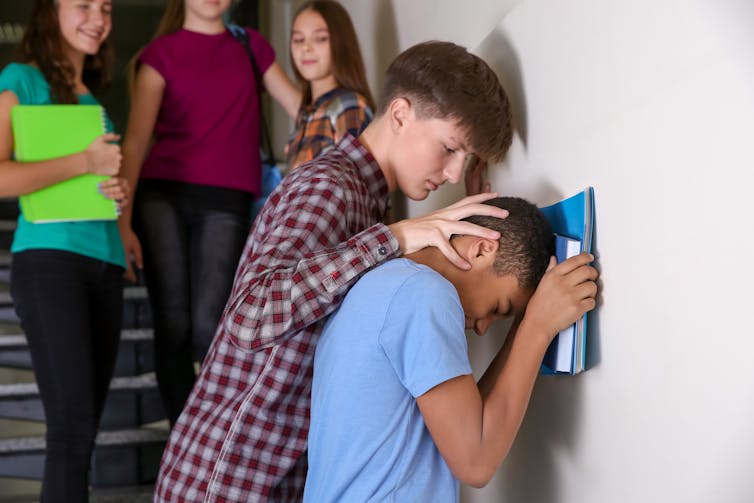Not every school’s anti-bullying program works – some may actually make bullying worse. Most anti-bullying programs available to schools haven’t been evaluated for effectiveness.
Karyn Healy, The University of Queensland
School bullying can have serious consequences for victims including depression, psychosis, self-harm and suicide. With increasing evidence of harm, a groundswell of school anti-bullying programs and campaigns in Australia and internationally have vowed to stamp out bullying.
The schools’ intentions are good, but often these programs have not been properly evaluated for effectiveness, and studies show some types of programs can actually make bullying worse.
School programs
There is no shortage of anti-bullying programs offered to schools. The programs are varied and can include teaching resources and discipline plans, as well as student and teacher training, parent meetings and improved playground supervision.
Most programs cite a theoretical base to support their approach but not an evaluation of the specific program. For instance, educational campaigns in many countries, including Australia and New Zealand, emphasise the role of student bystanders in standing up against bullying.
Educational videos show students how they can make a big difference by standing up for the victim when they witness bullying.
The theory behind using bystanders to address bullying goes back to an observational study conducted in 2001. Observational studies are where researchers observe behaviour in a natural setting, rather than placing participants in certain experimental conditions.
In the 2001 study, researchers observed 58 children aged 6-12 intervene in bullying. Most (57%) interventions stopped the bullying. Overall, the study showed bullying often stops when students spontaneously stand up for a bullied peer. Since then, many school-based anti-bullying programs have emphasised bystander action.
But a 2010 synthesis of many studies found programs encouraging students to help actually made bullying worse. This study was a meta-analysis, meaning it pulled together results of well-designed studies conducted at that time on the effectiveness of anti-bullying programs.
Read more:
Is your child less likely to be bullied in a private school?
There are several ways to explain these different findings. Firstly, in the observational study the effect on bullying was judged in the few seconds after the bystander action. We don’t know if bullying resumed the next day. The meta-analysis included studies that examined bullying weeks or months later. We know from previous research that actions that seem effective in the short-term can have harmful long-term effects.
There may also be crucial differences between naturally occurring bystander actions and those encouraged by schools. The effectiveness in natural situations may rely on who the student bystander is and their relationship with those involved in bullying. School programs may encourage students with poor skills to get involved which may escalate the situation.
Future research may explain differences between effective and ineffective bystander actions. In the meantime, schools should exercise caution in using this approach.

from shutterstock.com
Difference among programs
The 2010 meta-analysis showed that, overall, school-based anti-bullying programs decrease bullying and victimisation by around 20%, with similar reductions for cyber-bullying. But this and other meta-analyses report substantial differences between programs.
Another recent meta-analysis looked separately at anti-bullying programs in primary schools and high schools. On average, programs in primary schools were effective. But in high schools, anti-bullying programs were just as likely to make bullying worse as they were to improve it. The exact reason for these differences is not known.
Read more:
‘I don’t want to be teased’ – why bullied children are reluctant to seek help from teachers
There are many reasons why efforts to change behaviour may have unintended negative effects. Perhaps the emphasis on stopping bullying in high schools provokes student who bully and undermines the reputation of students who are bullied.
So, which programs work?
The 2010 meta-analysis showed programs that reduce bullying are likely to take more time to implement, involve parent meetings, firm disciplinary methods and improved playground supervision.
It can be hard for schools to know what programs are effective because this takes a lot of time. There are independent scientific organisations that evaluate evidence for program effectiveness. These include Blueprints (US) and the Early Intervention Foundation (UK).
To really know if a program works, research needs to compare outcomes over time between students who receive the program and students who don’t. It is also best to randomly allocate students or schools to receiving the program or not, to help ensure the groups are equivalent in the first place. These types of studies are called randomised controlled trials.
Read more:
Randomised control trials: what makes them the gold standard in medical research?
Programs that have been shown to be effective by randomised controlled trials include the Friendly Schools Program and Positive Behaviour for Learning. The Friendly Schools Plus program helps schools build supportive practices, teach social skills and build partnerships with parents. A randomised controlled trial showed this program reduced victimisation and observations of bullying over three years.
Positive Behaviour for Learning helps schools improve discipline by teaching expected behaviour and establishing clear rewards and consequences. It is widely used in Australian schools. A randomised controlled trial found this program reduced bullying in primary schools.
Schools are under great pressure to visibly take action against bullying. However, caution is needed, especially in high schools, because many programs that sound like a good idea can make bullying worse. Schools should stick with what they know works and only adopt new programs that have been adequately evaluated.![]()
Karyn Healy, Researcher, The University of Queensland
This article is republished from The Conversation under a Creative Commons license. Read the original article.























1:02 pm
11:14 pm
2:19 pm
7:01 pm
10:41 am
9:36 pm
11:32 pm
12:37 pm
11:58 am
8:23 pm
6:24 pm
10:48 am
7:25 am
11:38 pm
10:51 pm
9:11 pm
12:07 pm
7:38 am
7:06 am
5:31 am
- 1
- 2
- »
Post a commentTo post a review/comment please join us or login so we can allocate your points.